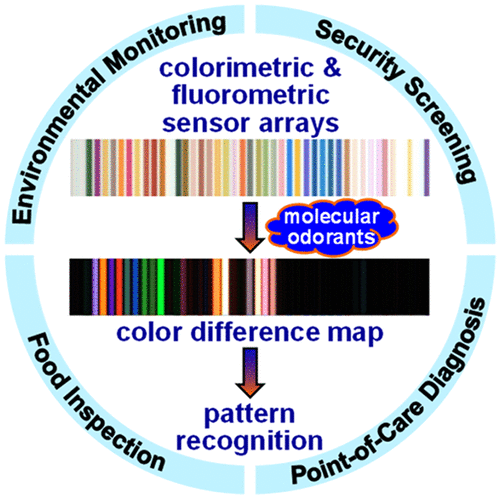当前位置:
X-MOL 学术
›
Chem. Rev.
›
论文详情
Our official English website, www.x-mol.net, welcomes your
feedback! (Note: you will need to create a separate account there.)
The Optoelectronic Nose: Colorimetric and Fluorometric Sensor Arrays
Chemical Reviews ( IF 51.4 ) Pub Date : 2018-09-12 00:00:00 , DOI: 10.1021/acs.chemrev.8b00226 Zheng Li 1 , Jon R. Askim 2 , Kenneth S. Suslick 1
Chemical Reviews ( IF 51.4 ) Pub Date : 2018-09-12 00:00:00 , DOI: 10.1021/acs.chemrev.8b00226 Zheng Li 1 , Jon R. Askim 2 , Kenneth S. Suslick 1
Affiliation

|
A comprehensive review on the development and state of the art of colorimetric and fluorometric sensor arrays is presented. Chemical sensing aims to detect subtle changes in the chemical environment by transforming relevant chemical or physical properties of molecular or ionic species (i.e., analytes) into an analytically useful output. Optical arrays based on chemoresponsive colorants (dyes and nanoporous pigments) probe the chemical reactivity of analytes, rather than their physical properties (e.g., mass). The chemical specificity of the olfactory system does not come from specific receptors for specific analytes (e.g., the traditional lock-and-key model of substrate–enzyme interactions), but rather olfaction makes use of pattern recognition of the combined response of several hundred olfactory receptors. In a similar fashion, arrays of chemoresponsive colorants provide high-dimensional data from the color or fluorescence changes of the dyes in these arrays as they are exposed to analytes. This provides chemical sensing with high sensitivity (often down to parts per billion levels), impressive discrimination among very similar analytes, and exquisite fingerprinting of extremely similar mixtures over a wide range of analyte types, in both the gas and liquid phases. Design of both sensor arrays and instrumentation for their analysis are discussed. In addition, the various chemometric and statistical analyses of high-dimensional data (including hierarchical cluster analysis (HCA), principal component analysis (PCA), linear discriminant analysis (LDA), support vector machines (SVMs), and artificial neural networks (ANNs)) are presented and critiqued in reference to their use in chemical sensing. A variety of applications are also discussed, including personal dosimetry of toxic industrial chemical, detection of explosives or accelerants, quality control of foods and beverages, biosensing intracellularly, identification of bacteria and fungi, and detection of cancer and disease biomarkers.
中文翻译:

光电鼻:比色和荧光传感器阵列
介绍了比色和荧光传感器阵列的发展和技术水平的全面回顾。化学感测的目的是通过将分子或离子物质(即分析物)的相关化学或物理特性转化为可分析的有用输出,从而检测化学环境中的细微变化。基于化学响应性着色剂(染料和纳米多孔颜料)的光学阵列探测分析物的化学反应性,而不是其物理性质(例如质量)。嗅觉系统的化学特异性并非来自特定分析物的特定受体(例如,传统的底物与酶相互作用的锁钥模型),而是嗅觉利用模式识别数百种嗅觉的联合反应受体。以类似的方式,化学反应性着色剂阵列可提供高维数据,这些数据来自这些阵列中的染料在暴露于分析物时的颜色或荧光变化。这提供了具有高灵敏度(通常低至十亿分之几的水平)的化学感应,非常相似的分析物之间的令人印象深刻的区分,以及在气相和液相中各种分析物类型上非常相似的混合物的精美指纹图谱。讨论了传感器阵列的设计和用于分析的仪器。此外,还对高维数据进行了各种化学计量和统计分析(包括层次聚类分析(HCA),主成分分析(PCA),线性判别分析(LDA),支持向量机(SVM),以及人工神经网络(ANN))的介绍和评论,以参考它们在化学传感中的用途。还讨论了各种应用,包括有毒工业化学药品的个人剂量测定,爆炸物或促进剂的检测,食品和饮料的质量控制,细胞内生物传感,细菌和真菌的鉴定以及癌症和疾病生物标志物的检测。
更新日期:2018-09-12
中文翻译:

光电鼻:比色和荧光传感器阵列
介绍了比色和荧光传感器阵列的发展和技术水平的全面回顾。化学感测的目的是通过将分子或离子物质(即分析物)的相关化学或物理特性转化为可分析的有用输出,从而检测化学环境中的细微变化。基于化学响应性着色剂(染料和纳米多孔颜料)的光学阵列探测分析物的化学反应性,而不是其物理性质(例如质量)。嗅觉系统的化学特异性并非来自特定分析物的特定受体(例如,传统的底物与酶相互作用的锁钥模型),而是嗅觉利用模式识别数百种嗅觉的联合反应受体。以类似的方式,化学反应性着色剂阵列可提供高维数据,这些数据来自这些阵列中的染料在暴露于分析物时的颜色或荧光变化。这提供了具有高灵敏度(通常低至十亿分之几的水平)的化学感应,非常相似的分析物之间的令人印象深刻的区分,以及在气相和液相中各种分析物类型上非常相似的混合物的精美指纹图谱。讨论了传感器阵列的设计和用于分析的仪器。此外,还对高维数据进行了各种化学计量和统计分析(包括层次聚类分析(HCA),主成分分析(PCA),线性判别分析(LDA),支持向量机(SVM),以及人工神经网络(ANN))的介绍和评论,以参考它们在化学传感中的用途。还讨论了各种应用,包括有毒工业化学药品的个人剂量测定,爆炸物或促进剂的检测,食品和饮料的质量控制,细胞内生物传感,细菌和真菌的鉴定以及癌症和疾病生物标志物的检测。











































 京公网安备 11010802027423号
京公网安备 11010802027423号